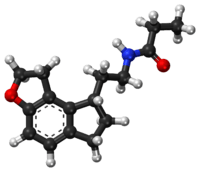Ramelteon
 | |
 | |
| Clinical data | |
|---|---|
| Trade names | Rozerem |
| AHFS/Drugs.com | Monograph |
| MedlinePlus | a605038 |
| Pregnancy category |
|
| Routes of administration | Oral (tablets) |
| ATC code | N05CH02 (WHO) |
| Legal status | |
| Legal status |
|
| Pharmacokinetic data | |
| Bioavailability | 1.8% |
| Protein binding | ~82% |
| Metabolism | Hepatic (CYP1A2-mediated) |
| Biological half-life | 1–2.6 hours |
| Excretion | Renal (84%) and fecal (4%) |
| Identifiers | |
| |
| CAS Number |
196597-26-9 |
| PubChem (CID) | 208902 |
| IUPHAR/BPS | 1356 |
| DrugBank |
DB00980 |
| ChemSpider |
9033484 |
| UNII |
901AS54I69 |
| KEGG |
D02689 |
| ChEMBL |
CHEMBL133775 |
| ECHA InfoCard | 100.215.666 |
| Chemical and physical data | |
| Formula | C16H21NO2 |
| Molar mass | 259.343 g/mol |
| 3D model (Jmol) | Interactive image |
| |
| |
| (verify) | |
Ramelteon, marketed as Rozerem by Takeda Pharmaceuticals North America, is a sleep agent that selectively binds to the MT1 and MT2 receptors in the suprachiasmatic nucleus (SCN), instead of binding to GABAA receptors, such as with drugs like zolpidem.
It however does not appear to speed the onset of sleep or the amount of sleep a person gets.[1] It is approved by the U.S. Food and Drug Administration (FDA) for long-term use.
Ramelteon does not show any appreciable binding to GABAA receptors, which are associated with anxiolytic, myorelaxant, and amnesic effects.
Medical uses
Ramelteon can be used for insomnia, particularly delayed sleep onset. It however does not appear to speed the onset of sleep or the amount of sleep a person gets.[1]
A systematic review, published in 2014, concluded "ramelteon was found to be beneficial in preventing delirium in medically ill individuals when compared to placebo."[2]
Adverse effects
Ramelteon has not been shown to produce dependence and has shown no potential for abuse, and the withdrawal and rebound insomnia that is typical with GABA modulators is not present in ramelteon.
Six percent of ramelteon-treated patients in clinical trials discontinued due to an adverse event, compared to 2% in the placebo arms. The most frequent adverse events leading to discontinuation were somnolence, dizziness, nausea, fatigue, headache, and insomnia. The United States official Prescribing Information warns of rare cases of anaphylactic reactions, abnormal thinking, and suicide in patients with pre-existing depression.
In mice treated with ramelteon for two years, increases in liver and testicular tumors were observed, but only at doses at least 20 times greater than the recommended human dose on a milligram/kilogram basis.[3]
Drug interactions
Ramelteon has been evaluated for potential drug interactions with the following medications and showed no significant effects: omeprazole, theophylline, dextromethorphan, and midazolam, digoxin and warfarin. There were no clinically meaningful effects when ramelteon was coadministered with any of these drugs.
A drug interaction study showed that there were no clinically meaningful effects or an increase in adverse events when ramelteon and the SSRI Prozac (fluoxetine) were coadministered. When coadministered with ramelteon, fluvoxamine (strong CYP1A2 inhibitor) increased AUC approximately 190-fold, and the Cmax increased approximately 70-fold, compared to ramelteon administered alone. Ramelteon and fluvoxamine should not be coadministered.[4]
Ramelteon has significant drug-drug interaction with the following drugs: amiodarone, ciprofloxacin, fluvoxamine, ticlopidine.
Ramelteon should be administered with caution in patients taking other CYP1A2 inhibitors, strong CYP3A4 inhibitors such as ketoconazole, and strong CYP2C9 inhibitors such as fluconazole.
Efficacy may be reduced when ramelteon is used in combination with potent CYP enzyme inducers such as rifampin, since ramelteon concentrations may be decreased.
Mechanism of action
Ramelteon is a melatonin receptor agonist with both high affinity for melatonin MT1 and MT2 receptors and selectivity over the MT3 receptor. Ramelteon demonstrates full agonist activity in vitro in cells expressing human MT1 or MT2 receptors, and high selectivity for human MT1 and MT2 receptors compared to the MT3 receptor.[5]
The activity of ramelteon at the MT1 and MT2 receptors is believed to contribute to its sleep-promoting properties, as these receptors, acted upon by endogenous melatonin, are thought to be involved in the maintenance of the circadian rhythm underlying the normal sleep-wake cycle. Ramelteon has no appreciable affinity for the GABA receptor complex or for receptors that bind neuropeptides, cytokines, serotonin, dopamine, noradrenaline, acetylcholine, and opioids. Ramelteon also does not interfere with the activity of a number of selected enzymes in a standard panel.
The major metabolite of ramelteon, M-II, is active and has approximately one tenth and one fifth the binding affinity of the parent molecule for the human MT1 and MT2 receptors, respectively, and is 17–25-fold less potent than ramelteon in in vitro functional assays. Although the potency of M-II at MT1 and MT2 receptors is lower than the parent drug, M-II circulates at higher concentrations than the parent producing 20–100-fold greater mean systemic exposure when compared to ramelteon. M-II has weak affinity for the serotonin 5-HT2B receptor, but no appreciable affinity for other receptors or enzymes. Similar to ramelteon, M-II does not interfere with the activity of a number of endogenous enzymes.
No published studies have indicated whether ramelteon, in humans, is more or less safe or effective than the hormone melatonin which it mimics; melatonin is much less expensive and is widely available over-the-counter in the US and Canada.[6] The biological action of melatonin is similar to that of ramelteon. Ramelteon has been directly compared to melatonin in cats, and Ramelteon had a significant (3 times) longer effect and had a more profound effect on the EEG of the sleeping cats.[7]
See also
References
- 1 2 Brasure, M; MacDonald, R; Fuchs, E; Olson, CM; Carlyle, M; Diem, S; Koffel, E; Khawaja, IS; Ouellette, J; Butler, M; Kane, RL; Wilt, TJ (December 2015). "Management of insomnia disorder". Comparative Effectiveness Reviews. 159. PMID 26844312.
- ↑ Chakraborti D, Tampi DJ, Tampi RR (March 2015). "Melatonin and melatonin agonist for delirium in the elderly patients". Am J Alzheimers Dis Other Demen. 30 (2): 119–129. doi:10.1177/1533317514539379. PMID 24946785.
- ↑ "www.accessdata.fda.gov" (PDF).
- ↑ "ROZEREM (ramelteon) Tablets. Full Prescribing Information" (PDF). Rozerem – Prescription Sleep Aid. Takeda Pharmaceuticals America, Inc.
- ↑ Owen RT (April 2006). "Ramelteon: profile of a new sleep-promoting medication". Drugs Today. 42 (4): 255–63. doi:10.1358/dot.2006.42.4.970842. PMID 16703122.
- ↑ Cardinali DP, Srinivasan V, Brzezinski A, Brown GM (May 2012). "Melatonin and its analogs in insomnia and depression". J. Pineal Res. 52 (4): 365–75. doi:10.1111/j.1600-079X.2011.00962.x. PMID 21951153.
- ↑ Miyamoto M, Nishikawa H, Doken Y, Hirai K, Uchikawa O, Ohkawa S (November 2004). "The sleep-promoting action of ramelteon (TAK-375) in freely moving cats". Sleep. 27 (7): 1319–25. PMID 15586784.
Sources and external links
- Safety and Efficacy Study of Ramelteon (TAK-375) Tablets for Sublingual Administration (SL) in Adults With Bipolar 1 Disorder: NCT01677182 on ClinicalTrials.gov
- Kato, K; Hirai, K; Nishiyama, K; Uchikawa, O; Fukatsu, K; Ohkawa, S; Kawamata, Y; Hinuma, S; Miyamoto, M (Feb 2005). "Neurochemical properties of ramelteon (TAK-375), a selective MT1/MT2 receptor agonist.". Neuropharmacology. 48 (2): 301–10. doi:10.1016/j.neuropharm.2004.09.007. PMID 15695169.
- Roth, T; Stubbs, C; Walsh, JK (Mar 2005). "Ramelteon (TAK-375), a selective MT1/MT2-receptor agonist, reduces latency to persistent sleep in a model of transient insomnia related to a novel sleep environment." (PDF). Sleep. 28 (3): 303–7. PMID 16173650.
- Rozerem Official Website
- Prescribing Information Data Sheet
- RxList.com
- Clinical Pharmacokinetic Monitoring of Midazolam in Critically Ill Patients in relation to midazolam as a drug-drug interaction to Rozerem